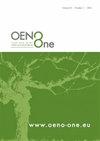Study of the effects of climatic conditions on the phenolic content and antioxidant activity of Austrian and Montenegrin red wines
IF 2.2
3区 农林科学
Q3 FOOD SCIENCE & TECHNOLOGY
引用次数: 0
Abstract
We evaluated the chemical composition and antioxidant activity of 30 red wines from Austria (cv. Cabernet-Sauvignon, Blaufraenkisch and Zweigelt) and 20 wines from Montenegro (cv. Cabernet-Sauvignon and Vranac) from three consecutive vintages: 2014, 2015 and 2016. We determined spectrophotometrically the contents of total phenol (TP), total anthocyanin (TA) and low- and high-molecular-weight proanthocyanidins (LMP and HMP respectively). We identified and quantified 18 phenolic compounds (hydroxycinnamic acids, hydroxybenzoic acids, stilbenes and flavan-3-ols) by high-performance liquid chromatography. In addition, we used Fourier-transform infrared spectroscopy for chemical analyses of the main wine parameters. Austrian autochthonous wines exhibited a similar chemical composition (alcohol 12.4 vol%, pH 3.38). Blaufraenkisch wines showed higher TP, HMP and LMP than Zweigelt wines; however, TA content was similar. Blaufraenkisch wines also showed higher phenolic acid, flavan-3-ol and stilbene contents than Zweigelt wines. Montenegrin autochthonous Vranac wines showed a typical chemical composition (alcohol 13.0 vol%, pH 3.42), and medium to high levels of phenols: TP, HMP, LMP, TA, HCA and flavan-3-ols. On the other hand, they showed a moderate stilbene content. Cabernet-Sauvignon wines from Austria and Montenegro exhibited some similarities in phenolic composition: TP, HMP, LMP and TA. There were notable variations in the phenolic acid and flavan-3-ol contents, especially the stilbene content, which was much higher in the Austrian wines than in the Montenegrin wines. These findings evidence an important impact of climatic conditions on these compounds. The antioxidant activity in all investigated wines was high and correlated strongly with TP, total phenol index, HMP and LMP in wines. The vintage influenced the chemical composition and content of all examined phenolic groups, except flavan-3-ols. Wines from the vintage with the best maturity (2015) contained the highest content of spectrophotometrically determined phenolic compounds and lowest level of phenolic acids and stilbenes. Principle component analysis showed that wines were mainly discriminated by variety and origin but not by vintage.气候条件对奥地利和黑山红葡萄酒酚类物质含量和抗氧化活性影响的研究
我们评估了奥地利30款红葡萄酒(赤霞珠、布劳夫兰基什和茨威格尔特)和黑山20款红葡萄酒的化学成分和抗氧化活性,这些葡萄酒分别来自2014年、2015年和2016年这三个连续年份。分光光度法测定了总酚(TP)、总花青素(TA)和低分子量和高分子量原花青素(分别为LMP和HMP)的含量。我们用高效液相色谱法鉴定并定量了18种酚类化合物(羟基肉桂酸、羟基苯甲酸、二苯乙烯和黄烷-3-醇)。此外,我们使用傅立叶变换红外光谱对葡萄酒的主要参数进行了化学分析。奥地利本土葡萄酒的化学成分相似(酒精含量12.4vol%,pH 3.38)。Blaufraenkisch葡萄酒的TP、HMP和LMP高于Zweigelt葡萄酒;但TA含量相近。Blaufraenkisch葡萄酒的酚酸、黄烷-3-醇和二苯乙烯含量也高于Zweigelt葡萄酒。黑山本土Vranc葡萄酒显示出典型的化学成分(酒精13.0体积%,pH 3.42),以及中高水平的酚类物质:TP、HMP、LMP、TA、HCA和黄烷-3-醇。另一方面,它们显示出中等的二苯乙烯含量。来自奥地利和黑山的赤霞珠葡萄酒在酚类成分上表现出一些相似之处:TP、HMP、LMP和TA。酚酸和黄烷-3-醇含量存在显著差异,尤其是二苯乙烯含量,奥地利葡萄酒的二苯乙烯含量远高于黑山葡萄酒。这些发现证明了气候条件对这些化合物的重要影响。所有葡萄酒的抗氧化活性都很高,并且与葡萄酒中的TP、总酚指数、HMP和LMP密切相关。年份影响了除黄烷-3-醇外的所有酚类化合物的化学组成和含量。成熟度最佳年份(2015年)的葡萄酒中,分光光度法测定的酚类化合物含量最高,酚酸和二苯乙烯含量最低。主成分分析表明,葡萄酒主要受品种和产地的影响,而不受年份的影响。
本文章由计算机程序翻译,如有差异,请以英文原文为准。
求助全文
约1分钟内获得全文
求助全文
来源期刊

OENO One
Agricultural and Biological Sciences-Food Science
CiteScore
4.40
自引率
13.80%
发文量
85
审稿时长
13 weeks
期刊介绍:
OENO One is a peer-reviewed journal that publishes original research, reviews, mini-reviews, short communications, perspectives and spotlights in the areas of viticulture, grapevine physiology, genomics and genetics, oenology, winemaking technology and processes, wine chemistry and quality, analytical chemistry, microbiology, sensory and consumer sciences, safety and health. OENO One belongs to the International Viticulture and Enology Society - IVES, an academic association dedicated to viticulture and enology.
 求助内容:
求助内容: 应助结果提醒方式:
应助结果提醒方式:


